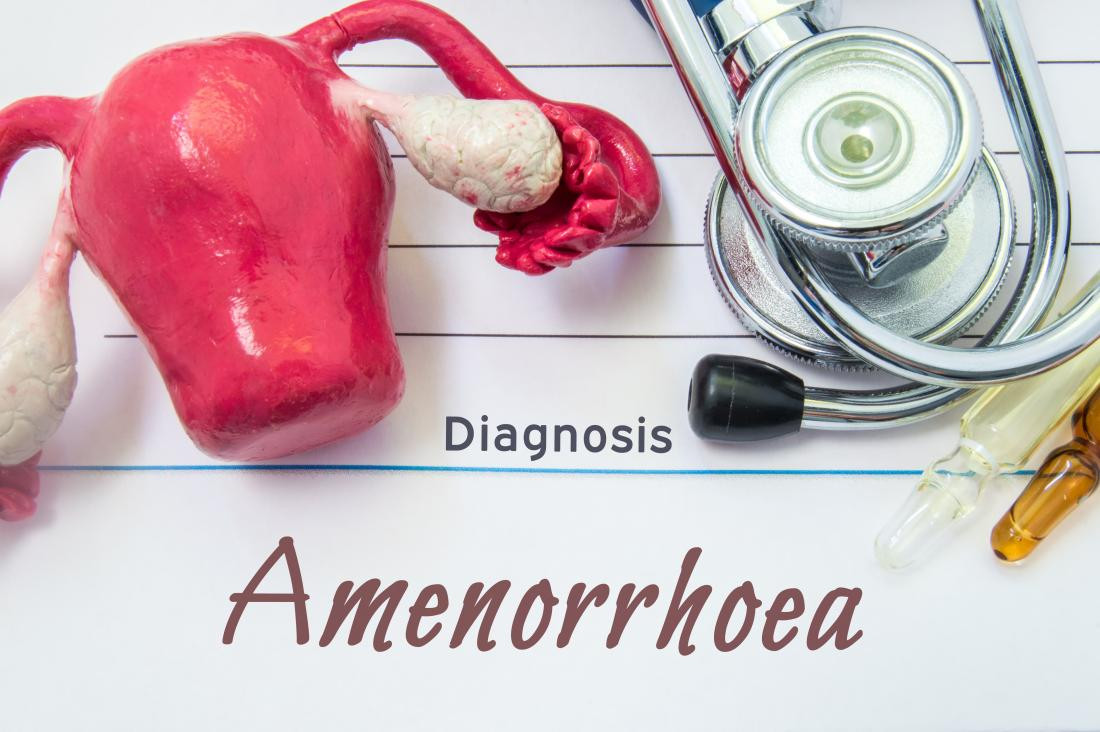Definisi
Secara umum, amenore adalah kondisi ketika seseorang tidak mengalami menstruasi atau haid. Amenore primer adalah suatu kondisi ketika seseorang belum mendapatkan haid pertama sampai pada usia 15 tahun atau tidak haid pada lima tahun pertama setelah adanya tanda pubertas pertama kali, seperti pembesaran payudara.
Amenore primer merupakan salah satu kasus yang langka terjadi. Contohnya di Amerika Serikat, amenore primer hanya terjadi pada 1% dari jumlah populasi total. Namun, amenore primer perlu diwaspadai karena dapat mengganggu kualitas hidup pasien kedepannya. Amenore primer paling sering disebabkan oleh adanya kelainan kromosom, seperti sindrom Turner, yang mencapai hingga 43% dari keseluruhan jumlah kasus amenore primer di Amerika Serikat. Pengobatan amenore primer bergantung dengan penyebab dan penyakit yang mendasarinya.
Penyebab
Penyebab dari amenore primer yang sering ditemukan adalah kelainan genetik pada ovarium (indung telur) dan ketidakstabilan hormon dari kelenjar pituitari dan hipotalamus otak. Kedua kelenjar ini memiliki peran untuk menjaga keseimbangan hormon reproduksi dan pertumbuhan pada manusia. Jika terjadi ketidakseimbangan pada kedua kelenjar tersebut, hal ini dapat menyebabkan terjadinya amenore primer. Selain itu, amenore primer juga dapat disebabkan karena adanya kelainan anatomi pada sistem reproduksi wanita, seperti tertutupnya atau tidak terbentuknya selaput dara pada vagina, adanya septum atau pembatas pada rahim, panjang vagina yang terlalu pendek, dan tidak terbentuknya serviks atau leher rahim.
Faktor Risiko
Beberapa faktor risiko terjadinya amenore primer adalah:
- Riwayat amenore pada keluarga
- Riwayat keluarga dengan menopause dini
- Adanya kelainan genetik atau kelainan kromosom
- Penyakit kronis yang memiliki dampak pada regulasi hormon, seperti PCOS (polycystic ovary syndrome)
- Adanya tumor pada hipotalamus dan kelenjar pituitari
- Terdapat kelainan anatomi pada bagian vagina atau sistem reproduksi
- Gangguan makan seperti anoreksia
Gejala
Gejala utama dari amenore primer adalah belum munculnya haid pertama hingga usia 15 tahun atau 5 tahun setelah adanya tanda-tanda pubertas. Terkadang tidak ada gejala lain yang menyertai. Namun, terdapat beberapa gejala lain yang dapat dialami, yaitu:
- Muka dan wajah terasa panas dan memerah
- Puting yang mengeluarkan cairan
- Vagina kering
- Nyeri pada panggul
- Nyeri kepala
- Gangguan penglihatan
- Jerawat
- Tumbuh rambut berlebihan pada wajah dan tubuh
Diagnosis
Untuk menegakkan diagnosis amenore primer, dokter akan melakukan wawancara tanya jawab atau anamnesia dengan pasien untuk mencari tahu riwayat dan kondisi pasien, kemudian melakukan pemeriksaan fisik, dan pemeriksaan penunjang untuk membantu penegakkan diagnosis.
Anamnesis dimulai dengan menanyakan riwayat keluhan utama pasien, keluhan penyerta bila ada, sudah berapa lama keluhan tersebut muncul, riwayat amenore dan penyakit hormonal serta penyakit kromosomal pada keluarga, riwayat aktivitas sehari-hari, riwayat pola makan, riwayat penyakit sebelumnya, dan riwayat pengobatan tertentu.
Selanjutnya, dokter akan melakukan pemeriksaan fisik. Pemeriksaan fisik dimulai dengan melakukan pemeriksaan tanda-tanda vital dan pemeriksaan fisik menyeluruh dari kepala hingga kaki bila dokter mencurigai adanya tanda dari kelainan regulasi hormon. Dokter juga dapat menilai tanda pubertas pasien menggunakan skala tertentu. Dan dokter dapat melakukan pemeriksaan pada bagian vagina bila dokter mencurigai adanya kelainan struktur anatomi pada organ reproduksi pasien.
Selain dari pemeriksaan fisik, dokter juga melakukan pemeriksaan penunjang untuk mengkonfirmasi diagnosis sebelumnya. Biasanya pemeriksaan yang disarankan adalah pemeriksaan kehamilan, pemeriksaan darah untuk melihat kadar hormon, dan pemeriksaan radiologi seperti USG untuk melihat kondisi organ reproduksi dan MRI untuk melihat kondisi kelenjar pituitari dan hipotalamus.
Terkadang diagnosis dari amenore primer yang tidak tepat dapat menyebabkan kesalahan diagnosis. Penyakit lain yang memiliki gejala mirip dengan amenore primer adalah malnutrisi, sindrom Kallman atau hipogonadotropik hipogonadisme, trias atlit wanita, stress emosional atau fisik, sindrom ovari polikistik, dan penyakit kronis lainnya.
Tata Laksana
Tata laksana dari amenore primer bergantung dengan penyebab yang mendasarinya. Pada kasus ketidakseimbangan hormon, maka akan dilakukan hormone replacement therapy atau terapi hormon untuk menyeimbangkan kadar hormon yang tidak teratur dalam tubuh. Untuk penyebab amenore primer yang disebabkan oleh kelainan struktur anatomi dan organ reproduksi, maka dibutuhkan adanya tindakan pembedahan atau operasi. Selain pengobatan tersebut, tata laksana yang dapat dilakukan adalah dengan melakukan tindakan yang bertujuan untuk mencegah komplikasi seperti pengobatan suportif untuk psikis pasien dengan melakukan konseling dan edukasi mengenai penyakit amenore primer.
Pasien dengan amenore primer membutuhkan perawatan yang cukup lama. Bila pengobatan berhasil, pasien tetap harus melakukan check up dengan dokter yang merawat untuk melihat perkembangan terapi dan sistem reproduksi. Pada beberapa kasus, pengawasan dapat berlangsung mulai dari 6 bulan hingga 2 tahun.
Komplikasi
Amenore primer tidak mengancam nyawa namun dapat menyebabkan komplikasi yang signifikan. Diantaranya adalah osteoporosis dan tulang keropos bila amenore primer berkaitan dengan kadar hormon estrogen yang menurun. Selain itu juga dapat menyebabkan infertilitas atau ketidaksuburan pada wanita. Dan juga dapat menyebabkan gangguan psikologis dan mental akibat menurunnya rasa percaya diri wanita.
Pencegahan
Tidak ada pencegahan khusus untuk mencegah amenore primer. Skrining yang cepat dibutuhkan terutama bila terdapat riwayat amenore primer di keluarga. Namun untuk wanita dengan amenore primer, disarankan untuk melakukan beberapa langkah berikut:
- Selalu menjaga pola makan dengan makan makanan yang bergizi seimbang, kaya akan vitamin, serat dan protein.
- Olahraga dan aktivitas fisik rutin untuk menjaga indeks massa tubuh
- Tidur yang cukup 7 hingga 8 jam sehari
Selain itu, edukasi kepada remaja putri mengenai haid pertama dan siklus haid normal juga dibutuhkan agar remaja putri lebih sadar mengenai tanda pubertas dan kapan harus berobat ke dokter jika mengalami amenorrhea. Topik mengenai haid dan kesehatan reproduksi adalah topik yang penting untuk diajarkan kepada para remaja sehingga topik mengenai hal-hal ini tidak dianggap hal yang tabu.
Kapan harus ke dokter?
Segeralah ke dokter bila tidak kunjung mengalami haid pertama pada usia 15 tahun, terutama bila terdapat riwayat yang sama dengan keluarga. Disarankan untuk mengunjungi dokter anak dengan subspesialisasi endokrin dan metabolik untuk dilakukan skrining secara menyeluruh.
Mau tahu informasi seputar penyakit lainnya? Cek di sini, ya!
- dr Vivian Keung
A. Gasner, A. Rehman. (2022). Primary Amenorrhea. From https://www.ncbi.nlm.nih.gov/books/NBK554469/ [Accessed October 4, 2022]
American Family Physician - Amenorrhea: A Systematic Approach to Diagnosis and Management. (2019). From https://www.aafp.org/pubs/afp/issues/2019/0701/p39.html [Accessed October 4, 2022]
Cleveland Clinic - Amenorrhea. (2020). From https://my.clevelandclinic.org/health/diseases/3924-amenorrhea [Accessed October 4, 2022]
Mayo Clinic - Amenorrhea. (2021). From https://www.mayoclinic.org/diseases-conditions/amenorrhea/symptoms-causes/syc-20369299 [Accessed October 4, 2022]
Medscape - Amenorrhea. (2019). From https://emedicine.medscape.com/article/252928-overview [Accessed October 4, 2022]











